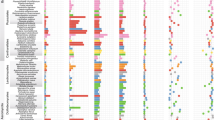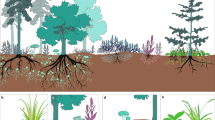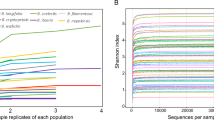Abstract
Mycorrhizae, the symbiotic associations of plant roots and fungal hyphae, are classic examples of mutualisms. In these ecologically important associations, the fungi derive photosynthetic sugars from their plant hosts, which in turn benefit from fungus-mediated uptake of mineral nutrients. Early views on the evolution of symbioses suggested that all long-term, intimate associations tend to evolve toward mutualism. Following this principle, it has been suggested that mycorrhizal symbioses are the stable derivatives of ancestral antagonistic interactions involving plant parasitic fungi1. Alternatively, mutualisms have been interpreted as inherently unstable reciprocal parasitisms, which can be disrupted by conflicts of interest among the partners2,3,4,5. To determine the number of origins of mycorrhizae, and to assess their evolutionary stability, it is necessary to understand the phylogenetic relationships of the taxa involved. Here we present a broad phylogenetic analysis of mycorrhizal and free-living homobasidiomycetes (mushroom-forming fungi). Our results indicate that mycorrhizal symbionts with diverse plant hosts have evolved repeatedly from saprotrophic precursors, but also that there have been multiple reversals to a free-living condition. These findings suggest that mycorrhizae are unstable, evolutionarily dynamic associations.
This is a preview of subscription content, access via your institution
Access options
Subscribe to this journal
Receive 51 print issues and online access
$199.00 per year
only $3.90 per issue
Buy this article
- Purchase on Springer Link
- Instant access to full article PDF
Prices may be subject to local taxes which are calculated during checkout

Similar content being viewed by others
References
Price, P. W. in Symbiosis As A Source Of Evolutionary Adaptation (eds Margulis, L. & Fester, R.) 262–272 (MIT Press, Cambridge, MA, 1991).
Bronstein, J. L. Conditional outcomes in mutualistic interactions. Trends Ecol. Evol. 9, 214–217 ( 1994).
Thompson, J. N. The Coevolutionary Process (Univ. Chicago Press, Chicago, 1994).
Herre, E. A., Knowlton, N., Mueller, U. G. & Rehner, S. A. The evolution of mutualisms: exploring the paths between conflict and cooperation. Trends Ecol. Evol. 14, 49– 53 (1999).
Pellmyr, O. & Huth, C. J. Evolutionary stability of mutualism between yuccas and yucca moths. Nature 372, 257–260 (1994).
Pirozynski, K. A. & Malloch, D. W. The origin of land plants: a matter of mycotrophism. Biosystems 6, 153–164 (1975).
Malloch, D. W., Pirozynski, K. A. & Raven, P. H. Ecological and evolutionary significance of mycorrhizal symbioses in vascular plants (a review). Proc. Natl Acad. Sci. USA 77, 2113–2118 ( 1980).
Smith, S. E. & Read, D. J. Mycorrhizal Symbiosis 2nd edn (Academic, San Diego, 1997).
Hawksworth, D. L., Kirk, P. M., Sutton, B. C. & Pegler, D. N. Dictionary Of The Fungi 8th edn (CAB International, Wallingford,, 1996).
Swofford, D. L. PAUP* 4. 0b2a (Sinauer, Sunderland, 1999).
Maddison, W. P. & Maddison, D. R. MacClade version 3 (Sinauer, Sunderland, 1992).
Pagel, M. The maximum likelihood approach to reconstructing ancestral character states of discrete characters on phylogenies. Syst. Biol. 48, 612–622 (1999).
Fitter, A. H. & Moyersoen, B. Evolutionary trends in root-microbe symbioses. Philos. Trans. R. Soc. (Ser. 351) 1345, 1367–1375 (1996).
Trappe, J. M. Fungus associates of ectotrophic mycorrhizae. Bot. Rev. 28, 538–606 (1962).
Ashton, D. H. Studies on the mycorrhizae of Eucalyptus regnans F. Muell. Aust. J. Bot. 24, 723–741 (1976).
Malajczuk, N., Molina, R. & Trappe, J. M. Ectomycorrhiza formation in Eucalyptus. I. Pure culture syntheses, host specificity and mycorrhizal compatibility with Pinus radiata. New Phytol. 91, 467– 482 (1982).
Smits, W. T. M. Dipterocarpaceae: Mycorrhizae and regeneration (Tropenbos Foundation, Wageningen, 1994).
Nuhamara, S. T., Hadi, S. & Bimaatmadja, E. I. in Proceedings of the 6th North American Conference on Mycorrhizae (ed. Molina, R.) 439 (Forest Research Laboratory, Oregon State Univ., 1985).
Danielson, R. M. Ectomycorrhizal associations in jack pine stands in north-eastern Alberta. Can. J. Bot. 62, 932–939 (1984).
Molina, R. & Trappe, J. M. Patterns of ectomycorrhizal host specificity and potential among pacific northwest conifers and fungi. Forest Sci. 28, 423–458 (1982).
Kropp, B. R. & Trappe, J. M. Ectomycorrhizal fungi of Tsuga heterophylla. Mycologia 74, 479– 488 (1982).
Bruns, T. D. Thoughts on the processes that maintain local species diversity of ectomycorrhizal fungi. Plant Soil 170, 63– 73 (1995).
Hibbett, D. S. & Thorn, R. G. in The Mycota Vol. VII Systematics and Evolution (eds McLaughlin, D. J., McLaughlin, E. G. & Lemke, P. A.) (Springer, in the press).
Cooke, R. C. & Rayner, A. D. M. Ecology of Saprotrophic Fungi (Longman, New York, 1984).
Leake, J. R. & Read, D. J. in The Mycota Vol. IV Environmental and Microbial Relationships (eds Wicklow, D. T. & Söderström, B. E.) 281–301 (Springer, Berlin, 1997).
Pellmyr, O., Leebens-Mack, J. & Huth, C. J. Non-mutualistic yucca moths and their evolutionary consequences. Nature 380, 155– 156 (1996).
Clay, K. in Coevolution of Fungi with Plants and Animals (eds Pirozynski, K. A. & Hawksworth, D. L.) 79–105 (Academic, San Diego, 1988).
Lamb, R. J. Effect of D-glucose on utilization of single carbon sources by ectomycorrhizal fungi. Trans. Br. Mycol. Soc. 63, 295– 306 (1974).
Swann, E. C. & Taylor, J. W. Higher taxa of basidiomycetes: an 18S rRNA perspective. Mycologia 85, 923 –936 (1993).
Acknowledgements
We thank M. Pagel for providing a copy of Discrete; USDA, DAOM and other sources for fungal samples; J.-M. Moncalvo and R. Vilgalys for access to unpublished sequences; and J. Bronstein for helpful comments. This work was supported by grants from the NSF.
Author information
Authors and Affiliations
Corresponding author
Supplementary Information
Rights and permissions
About this article
Cite this article
Hibbett, D., Gilbert, LB. & Donoghue, M. Evolutionary instability of ectomycorrhizal symbioses in basidiomycetes . Nature 407, 506–508 (2000). https://doi.org/10.1038/35035065
Received:
Accepted:
Issue Date:
DOI: https://doi.org/10.1038/35035065
This article is cited by
-
Impact of model assumptions on the inference of the evolution of ectomycorrhizal symbiosis in fungi
Scientific Reports (2022)
-
Linking Genes to Traits in Fungi
Microbial Ecology (2021)
-
Oak displays common local but specific distant gene regulation responses to different mycorrhizal fungi
BMC Genomics (2020)
-
A mechanistic explanation of the transition to simple multicellularity in fungi
Nature Communications (2020)
-
Unique and common traits in mycorrhizal symbioses
Nature Reviews Microbiology (2020)
Comments
By submitting a comment you agree to abide by our Terms and Community Guidelines. If you find something abusive or that does not comply with our terms or guidelines please flag it as inappropriate.



